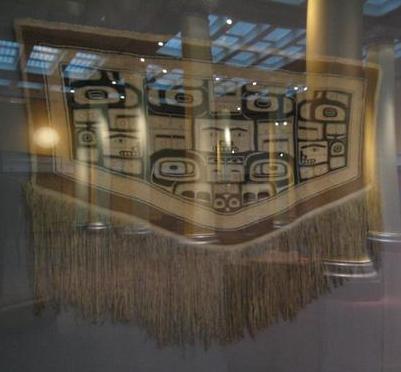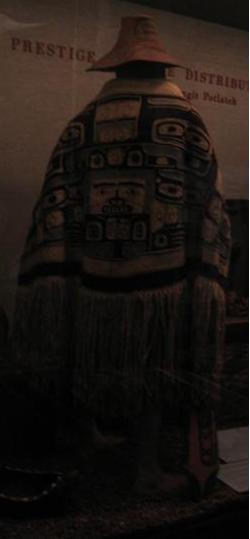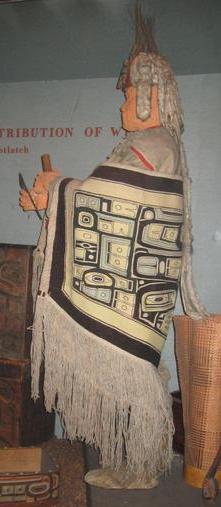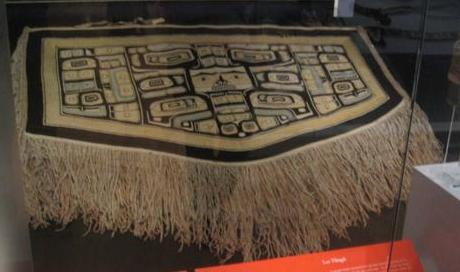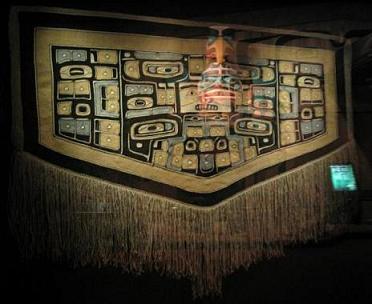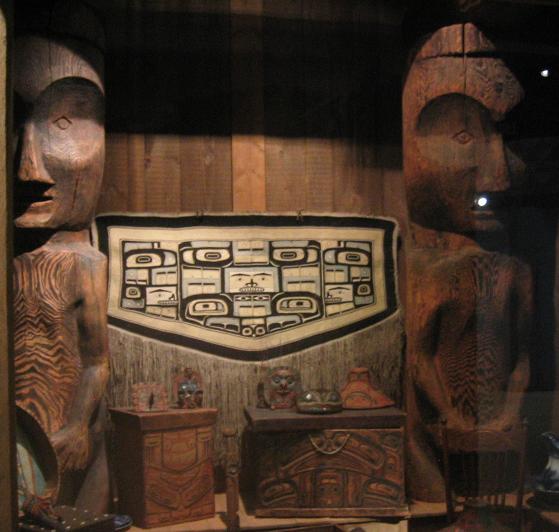Subject: chief / shaman
Culture: Tsimshian, Tlingit, other Northwest Coast Tribes
Setting: Potlatch, Northwest Coast late 19th - early 20thc
Object: naxeein Chilkat dancing blanket / robe
American Museum of Natural History > Hall of Northwest Coast Indians *
"Prestige and the Distribution of Wealth: The Tlingit Potlatch"
* Brooklyn Museum > Arts of the Americas
"Manta de baile de Chilkat Artista Tlingit Chilkat, principios del siglo XX Costa noroeste, Estados Unidos o Canada
Lana de cabra montes, lana comercial, corteza de cedro ...
Las mantas de baile de Chilkat eran usadas en ceremonias a cuando se recibian visitantes durante las elaboradas reuniones de potlatch. Este ejemplo pudo haber sido encargado por miembros de la elite de la tribu de Tlingit Chilkat y usado por hombres y mujeres para representar la identidad de clan y estatus. Una mujer la habría tejido con lana de cabra montes y corteza de cedro en colores neutrales obtenidos del liquen, cobre, corteza de cicula y orina. El proceso entero habría tornado entre seis meses y un año.
*
event photos <
* American Museum of Natural History > Hall of Northwest Coast Indians
"Prestige and the Distribution of Wealth: The Tlingit Potlatch"
Royal Ontario Museum > Gallery of Canada -- First Peoples *
Houston Museum of Natural Science > McGovern Hall of the Americas *
"Chilkat Blanket Tlingit, Alaska, 1880-1900
Woven from mountain goat wool and cedar bark, Chilkat robes, also known as 'dancing blankets,' were worn on ceremonial occasions. Women created these intricate weavings, painstakingly reproducing crest designs that had been painted on wooden pattern boards. This type of weaving originated with the Tsimshian and spread to other groups through intermarriage. The right to wear a Chilkat is inherited."
* Carnegie Museum of Natural History > Alcoa Foundation Hall of American Indians
"CHILKAT BLANKET Tlingit, Klukwan, late 1800s
A Chilkat Tlingit woman took at least six months to spin the yarn of mountain goat hair for this blanket. For the warp she included yellow cedar bark in its core. Then she spent another six months weaving this intricately twined dancing robe with the diving whale as the central design. The finished robe was worn on ceremonial occasions, when its long fringe swayed with the movements of the dancer."
National Museum of the American Indian Heye Center > Listening to Our Ancestors *
"... The central face of the Naxeen (Chilkat robe) conveys the consciousness in all living things. ..."
* National Museum of the American Indian Heye Center > Listening to Our Ancestors
"Naaxein (Chilkat robe) representing a Killer Whale chasing a seal,
1870-1900 Mountain goat will, shredded yellow cedar bark."
National Museum of the American Indian Heye Center > Listening to Our Ancestors *
"Naaxein (Chilkat robe) depicting the Diving Whale, 1870-1900
Mountain goat wool, shredded yellow cedar bark."
"Naaxein k'oodas' (Chilkat tunic) with clan crests, ca. 1875
Mountain goat wool, shredded yellow cedar bark, wood plugs, animal fur."
